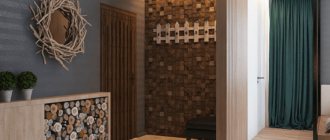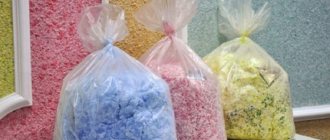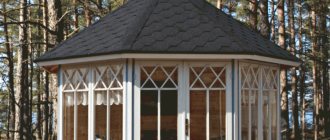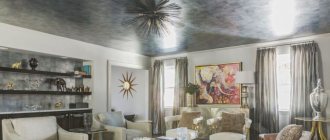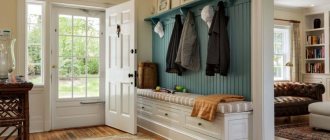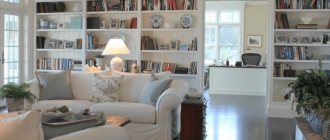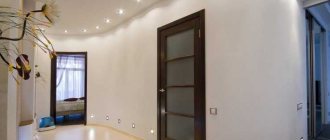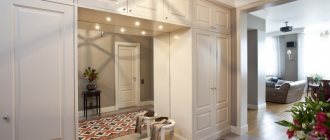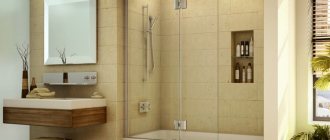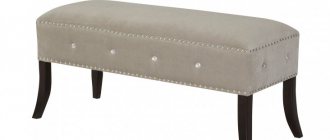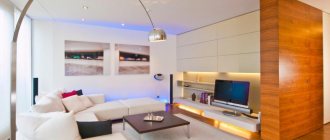What material is wallpaper made from?
For the production of wallpaper, not only paper is used, but also other materials, for example, textiles or vinyl. It is important to remember that the quality of finishing wallpaper depends on the properties of the material used for its production.
Wallpaper made from low-quality materials or unsuitable for the front room can reduce the space, shine unnaturally, or simply not fit with the overall design of the living space. To understand which wallpaper to choose for the hallway, you need to familiarize yourself with the existing varieties.
Wallpaper texture
You can consider washable wallpaper as one of the most practical options; fortunately, there is plenty on the market. Vinyl wallpaper is most often found among this type of wallpaper. Dirt does not penetrate into the structure of vinyl wallpaper, but simply dries on the surface, after which it can be easily wiped off with a regular rag. With the development of industry, new types of wallpaper appear.
To decorate the corridor and hallway, wallpaper is often used that imitates stone, wood, leather and other finishing materials in terms of tactile sensations. Wallpaper manufacturers achieve striking similarity in relief with natural materials.
You can choose glass wallpaper that is resistant to solvents and can therefore be repainted several times. Dirty areas on glass wallpaper can be scrubbed with a brush without damaging the material.
Read: Cabinet in the hallway - an overview of all types, examples of interior design (105 photos)
A non-standard idea for wallpaper for a hallway is the use of natural materials in their production. Such wallpapers are made to order in accordance with the client’s wishes and are quite expensive, but they provide aesthetic pleasure.
Recently, liquid wallpaper has been widely used. They are non-toxic, and their advantage is good contact with the walls, a pleasant texture to the touch, the ability to repaint and resistance to external influences, as a result of which paper wallpapers usually peel off from the wall. Thanks to its unique composition, liquid wallpaper fills small cracks and depressions in the wall, which allows you to save on leveling and plastering the walls.
It happens that serious unevenness is visible on the walls. In this case, embossed wallpaper will help disguise the unevenness. Adding pieces of aluminum foil to the texture of the wallpaper will give ordinary paper wallpaper a metallic shine. You can stick the foil onto the wallpaper yourself, adding a little imagination. What you do with your own hands will always be appreciated by others.
Wallpaper for a small hallway should not be chosen with large patterns, as they reduce the already small space. Wallpaper with a small pattern or with a projection effect will help to visually increase the area of the hallway. Using two contrasting colors of wallpaper for the hallway in an apartment will delimit the space if the room is narrow and long. The contrast will create the effect of dividing the room into separate zones, which can be furnished differently depending on the functional purpose.
When deciding which wallpaper to choose for the hallway, it is important to take into account the decor in the room, the color of the furniture, the texture and color of the materials used to decorate the ceiling and floor. With a successful combination of all factors and the right choice of wallpaper, the hallway will give the owner comfort and warmth, and will create a pleasant impression for guests when visiting the apartment.
Read: Hanger in the hallway - the most stylish models for the hallway (95 photos)
Criterias of choice
It is necessary to purchase finishing, taking into account not only the advantages and disadvantages of a specific area, but also the entire house. For a small apartment, it is recommended to choose wallpaper for the hallway according to tone, since there are no windows in the room. The decor and decoration of the front walls should be harmoniously combined with the overall interior.
When choosing, it is also recommended to pay attention to the fact that the wallpaper:
- had good air permeability, eliminating the proliferation of pathogenic microorganisms, the formation of fungi and mold;
- did not lose their original appearance under the influence of abrasion and impact loads;
- did not accumulate dust and did not cause an allergic reaction among residents of the apartment.
Since a lot of dust and dirt from the street settles on the surface of the corridor walls, when choosing wallpaper it is necessary to give preference to options that provide for periodic wet cleaning.
For the hallway, wallpaper that imitates plaster, stone, brick or tile is most often used. In the photo of wallpaper for the hallway you can see what a specially selected finishing option looks like, matching the interior of the room.
Red color in the interior
For example, when using red color in the interior of the living room, you should not abuse its concentration
.
It is better to highlight one or more elements with this color, subordinating to them the rest of the interior details, made in a neutral tone. restrained shades to decorate the room : brick, terracotta or coral.
Red color can be used more intensively in the kitchen interior, as it actively stimulates digestion and increases appetite. However, even when decorating a kitchen, it is worth showing restraint and avoiding excessive enthusiasm for red.
, which can cause unexpected attacks of aggression.
Vinyl
The finishing material has a porous surface and consists of a top vinyl layer and a backing, which can be paper or non-woven. Such wallpaper is quite expensive, and the high cost is not justified, since when combined with wallpaper glue, the chemical material can emit formaldehyde vapors for 4 years.
Vinyl wallpaper on a paper basis has low breathability and can cause the formation of a damp environment, as well as the appearance of fungi and pathogenic microorganisms.
Non-woven
This wallpaper is fire-resistant, dense, breathable, resistant to sunlight and is perfect for decorating a hallway flooded with natural light.
Due to the special texture of the material, this wallpaper can be used to hide defects on the walls. The disadvantage of this option is that non-woven coatings require a careful approach, while they accumulate a large amount of dust on the surface.
Huge selection of wallpapers
Sometimes it is necessary to hide an unsuccessful layout, niches, low ceilings, or long lengths. Therefore, it is important to choose the right wallpaper for a beautiful hallway.
The front door is the dirtiest place; you need to choose a coating that is resistant to frequent washing.
Textile wallpaper
The finishing material is a covering with fabric threads glued to a paper backing, and allows you to create a luxurious design with an emphasis on the well-being of the owner. Textile wallpaper is intended for rooms with a stable level of humidity.
The process of pasting such wallpaper is quite difficult, since glue is not allowed to get on the front surface. Only the wall needs to be covered with glue, which is not always enough for good adhesion.
Paper wallpaper
Budget option, but difficult to stick. Carefully coat the strip of wallpaper, fold it in half, then apply glue to the wall.
Paper swells quickly and is easily torn or deformed. Even on the wall, it can warp and wrinkles form, which are difficult to smooth out.
Look also here:
Algorithm for radiation examination of patients- Interior design of a hallway in an apartment: tips and ideas
- Ottoman in the hallway - what choice should you make in 2021 and why?!
Liquid
Manufacturers are constantly developing and offering different ideas for wallpaper for the hallway. Liquid wallpaper, reminiscent of glue wool, is one of the new products.
They are produced in special packaging, in which they are diluted with warm water. Afterwards the composition is closed and left for a day. The walls are covered with the finished mixture. The coating is heterogeneous and looks like a mosaic.
If desired, it is possible to make different drawings. To do this, you first need to make a sketch on the wall, and then fill it with the selected colors of the liquid facing material. When applying, it is important to avoid contact with water droplets on the surface.
Combined wallpaper
Designers offer the best solution - washable or liquid wallpaper. A very unusual option is a combination with vinyl, and washable ones at the door. Style and practicality are the main criteria for choosing the design of a hallway.
Combination with decor style
Wallpaper for the front room should be chosen so as to maintain the integrity of the image of the entire apartment.
Wallpaper in a classic style should be restrained and have an elegant appearance. Both plain and decorative options with different motifs are suitable. It is recommended to choose textile or non-woven wallpaper.
Modern style implies rigor, functionality, purity of colors and smooth lines. Symmetrical and asymmetrical figures or photo wallpapers are used as a print. Plain options are also acceptable. With the help of such wallpaper you can transform your space. Wallpaper for a small hallway must be light.
Finishing material in the Scandinavian style involves decorating the walls with plain light wallpaper in cool colors. Patterns are allowed. You can also choose wallpaper with smooth fittings or Scandinavian patterns.
The following are considered fashionable:
- alternating horizontal and vertical stripes when gluing the canvases;
- using two close shades to accentuate the walls;
- patchwork technique, which is an imitation of patchwork;
- zoning of space and gluing, taking into account the specifics of the design.
How to choose wallpaper in the hallway: photos and types of materials
There are so many types of wallpaper that it is very easy to get confused in all this variety. Their main characteristics, texture and color are also important here. To make your choice easier, we recommend that you familiarize yourself with the most popular ones in more detail.
Related article: Hinges for aluminum doors and other suitable fittings for this type of door structure
An original solution is to stick wallpaper that imitates brick in the hallway.
Types of wallpaper, or choosing the right wallpaper for the hallway:
- Non-woven wallpaper is often used for painting. This practical and wear-resistant material is very easy to stick to the wall. If you want to create a stylish and laconic option, then this option is the ideal solution for your corridor.
- Vinyl wallpaper is durable and has an unusual texture that can hide all minor flaws in the walls. This material is available in a wide range of colors and shades, and thanks to the film on top of the pattern, they can be washed.
- Fiberglass wallpaper is one of the most modern materials. They are durable, strong, environmentally friendly and moisture resistant. Walls decorated with such canvases can be repainted many times.
- Paper wallpaper is not suitable for the hallway. They are fragile and short-lived, and they cannot be washed. By decorating the corridor with such materials, you will update the renovation annually.
- Liquid wallpaper has a very interesting texture. They are applied to the wall in the same way as decorative plaster. They can be cleaned with a damp sponge, and if some area of the wall is completely dirty, then in this place you can remove the layer of liquid wallpaper and reapply the same mixture.
- Photo wallpapers look fascinating. With their help, you can not only give the interior an original appearance, but also visually increase the space.
- Textile wallpaper looks luxurious, but it is not advisable to use it in the hallway as the main material. A combination of two types of wallpaper will look good; for example, you can use vinyl material as a basis, and in some places insert fabric panels in a frame.
- Natural wallpaper is suitable for interiors in eco or feng shui style.
All the types we present have their advantages and disadvantages. The best result can be achieved by combining different types of wallpaper. If you stick moisture-resistant, non-staining wallpaper in places that are most susceptible to contamination, and decorate the rest of the hallway with light-colored materials.
Related article: DIY headboard
Color
The color of the wallpaper for the hallway should be in harmony with the colors of the floor and doors. When using dark wallpaper, additional lighting is required, while light wallpaper requires constant care.
White wallpaper in the front room creates a feeling of comfort. Set items and decors on a light background will look attractive.
Black wallpaper is suitable for spacious rooms. They give the hallway an elegant look.
Blue wallpaper is recommended for use in both small and large rooms. Wooden decors look good against this background.
Gray wallpaper makes it possible to easily and harmoniously combine different shades.
For a narrow and small hallway, it is recommended to use light wallpaper in calm shades. For a small front, it is also recommended to choose matte canvases without reliefs. For expressiveness, two walls can be decorated with wallpaper with complex patterns, covering the remaining walls with plain ones.
